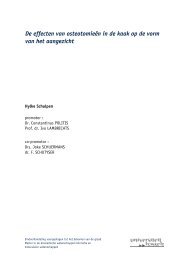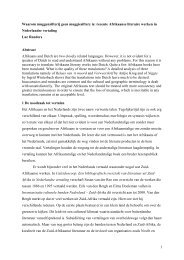Planning Problems in Intermodal Freight Transport ...
Planning Problems in Intermodal Freight Transport ...
Planning Problems in Intermodal Freight Transport ...
You also want an ePaper? Increase the reach of your titles
YUMPU automatically turns print PDFs into web optimized ePapers that Google loves.
present a modell<strong>in</strong>g approach focus<strong>in</strong>g on the comparative evaluation of conventional and<br />
advanced rail/road term<strong>in</strong>al equipment. The modell<strong>in</strong>g tool set consists of a micro-model to<br />
compare alternative term<strong>in</strong>al designs and a macro-model to analyze the attractiveness of the<br />
<strong>in</strong>termodal transport cha<strong>in</strong>. The micro-model <strong>in</strong>corporates an expert system, a simulation<br />
model and a cost calculation module. The expert system assists users to form technically<br />
sound term<strong>in</strong>al designs. The simulation model is used to determ<strong>in</strong>e tra<strong>in</strong> and truck service<br />
times, which are then compared to predeterm<strong>in</strong>ed service criteria. For each accepted term<strong>in</strong>al<br />
design a cost-versus-volume curve is calculated. Truck wait<strong>in</strong>g time costs are taken <strong>in</strong>to<br />
account. The micro-model reveals that each design is effective for a certa<strong>in</strong> cargo volume<br />
range and is restricted by capacity limitations. The effects of an efficient term<strong>in</strong>al operation <strong>in</strong><br />
conjunction with advanced rail operat<strong>in</strong>g forms is further <strong>in</strong>vestigated <strong>in</strong> the macro-model.<br />
The discrete event simulation model of Rizzoli et al. [12] can be used to simulate the<br />
processes <strong>in</strong> a s<strong>in</strong>gle term<strong>in</strong>al or <strong>in</strong> a rail network, connect<strong>in</strong>g several rail/road term<strong>in</strong>als<br />
through rail corridors. The objective of the model is to assess the impact of various<br />
technologies and management policies to enhance term<strong>in</strong>al performance and to understand<br />
how an <strong>in</strong>crease <strong>in</strong> <strong>in</strong>termodal traffic affects term<strong>in</strong>al performance.<br />
Two studies discuss the simulation of rail/rail <strong>in</strong>termodal term<strong>in</strong>als. Meyer [13] faces<br />
the design problem of a rail/rail term<strong>in</strong>al <strong>in</strong> a hub-and-spoke system for the exchange of a<br />
maximum of six tra<strong>in</strong>s at a time. In addition, the term<strong>in</strong>al should be able to handle a limited<br />
volume of rail/road exchanges. Dynamic computer simulation with Petri-net applications was<br />
developed to determ<strong>in</strong>e required capacity for cranes and <strong>in</strong>ternal transport systems, and the<br />
most efficient arrival pattern of tra<strong>in</strong>s. Bontekon<strong>in</strong>g [14] develops a simulation model to<br />
perform a systematic comparison between various hub exchange facilities <strong>in</strong> an <strong>in</strong>termodal<br />
rail network. Her ma<strong>in</strong> objective is to identify favourable operational conditions for an









